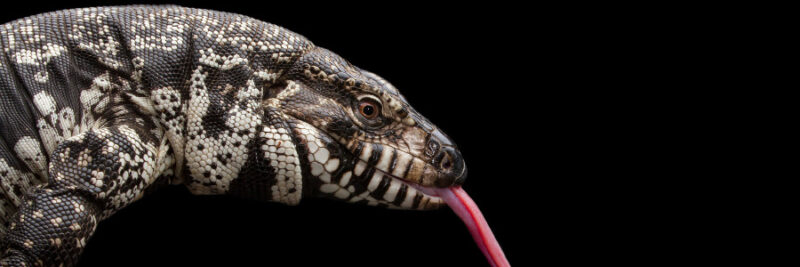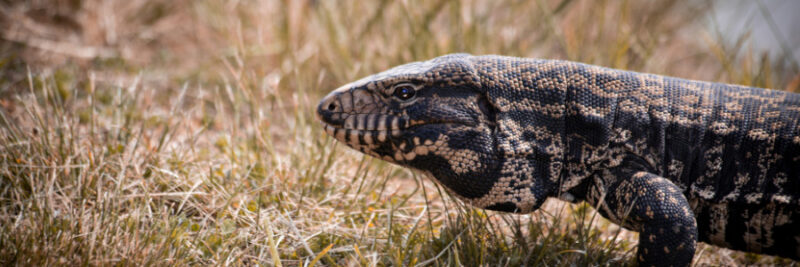Alright new tegu keepers, are you ready to dive into properly caring for one of the most impressive and personable lizards – the magnificent tegu? From Argentine black and whites to Colombians, these burly giants make fantastic pets when set up properly.
In this beginner’s guide, we’ll give you everything you need to know to construct the ideal habitat, feed properly, handle gently, and keep your new big buddy healthy and happy. Let’s get started!
Introduction to The Remarkable Tegu

Native to South America, tegus comprise several species of impressively large lizards reaching 4-5 feet long as stocky adults. Desired for their intelligence, dog-like personalities, and affectionate tendencies when socialized, they do require very sizable enclosures with specific heating to house their bulk. But the investment pays dividends!
Constructing Their Mini-Mansions
While hatchlings occupy small enclosures, mature tegu habitats require some serious handiwork to create their homesteads.
Sizing Their Digs
House babies in 6 x 3 x 2 foot enclosures, upgrading juveniles after a year to 8 x 4 x 4 feet minimum. These dimensions are bare minimums – larger is always better! Custom building is ideal to provide over 15 square feet of floorspace for their bulk as adults. Sturdy wood construction with good ventilation is essential.
Heating & Lighting Like the Tropics
Use overhead ceramic heat emitters to produce a focal basking spot reaching 105°F while allowing a cooler gradient to 75°F on the other end. Pair with Reptisun T5 High Output UVB fluorescent tubes for their health. Provide 10-12 hours of daytime light.
Tegu-Proofing Interiors
Include a large pond area, ample burrowing substrate for tunneling, live plants, and anchor half-log basking platforms and climbing branches securely. Use orchid bark or organic topsoil substrates to retain some humidity while avoiding impaction risks.
Feeding Their Hearty Appetites

In captivity, provide a diverse balanced diet including:
Whole Prey Variety
Feed fuzzies, mice, rats and quail along with eggs and eco-friendly cat food. Offer appropriate greens, vegetables fruits including figs, berries and melon.
Supplements & Hydration
Lightly dust rodents with ZooMed Repti Calcium and multivitamins to provide additional nutrients. Always offer fresh, dechlorinated water in bowls big enough to soak in.
Safe Handling & Bonding

While tegus rarely bite intentionally, respect their long claws and strong jaws with proper handling.
Support & Control Positioning
Approach new tegus slowly, then fully support their underside & tail base when grasping. Avoid pulling tails or putting them in vulnerable defensive positions.
Reading Body Language
Look for tense muscles, hissing, darkened jowls/skin and defensive postures to avoid confrontation or injury due to extreme fear.
Maintaining Health & Hygiene
Stay vigilant for changes in appetite, skin abnormalities and decreased energy:
Assisting Shedding
Increase soaking time and habitat humidity for stuck shed. Consider adding supplements if chronic shedding issues occur. Gently help remove stubborn skin with a soaked q-tip if needed.
Establishing Exotic Veterinary Care
Find qualified herp vets early on to establish preventative care relationships including annual fecals to check for parasites. Schedule immediate appointments if tegus seem lethargic or stop eating.
Frequently Asked Beginner Tegu Questions
While demanding larger housing and rodent-only diets, tegus become very interactive pets when handled regularly, making them good for beginners who thoroughly research proper care. Always use caution though - they are very strong!
Appropriately sized enclosures for age, basking overhead heating around 105°F, ambient heat around 75-80°F, UVB lighting on 10-12 hours daily, humidity around 60-80%, large water container, burrowing substrate, hides and anchoring climbable decor.
Hatchling tegus can begin in 6 x 3 x 2 foot enclosures. But adults require a bare bare minimum of 8 x 4 x 4 feet of secure floorspace - larger is always better!
Hatchlings can eat daily but juvenile and adult tegus do best with whole prey like fuzzies or mice 2-3 times weekly, supplemented with egg, greens and vegetables on other days. Always access to fresh water!
And there you have it budding tegu keepers – we covered all the fundamentals for getting started on the right foot with your awesome new addition! Let me know any other questions. Happy herping!
